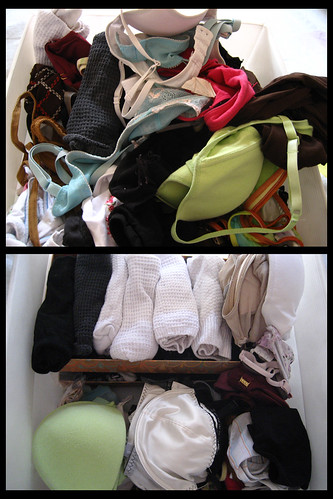 There are three main models for a Knowledge base.
There are three main models for a Knowledge base.Let's call them the sock drawer, the library and the supermarket display.
With the sock drawer (see top picture), if you are anything like me, you pile all your clean washing into the drawer, and know that the hard work will be done when you search (often early in the morning, in the half-light) for a pair of matching socks with no holes. All the work is done by the searcher, and very little by the storer. The knowledge base equivalent is the uncontrolled filing structure, where you rely on a good search engine to find what you want. Dump it all in, then search.
The library (or the organised sock drawer, see bottom picture) is an organised store. You know the category, you know the title, and you find the book (or you know the drawer, and the relevant section, and you find a rolled pair of socks). The work is distributed between the seeker and the storer. The knowledge base equivalent is the organised and tagged knowledge store, where you can browse or search for the knowledge you know you need.
The supermarket display goes one step further. In my local supermarket, for example, you can find a section that displays pasta, pasta sauce, parmesan cheese and Italian wine, all within the same attractive display. Without searching, you are presented with all the ingredients for an Italian meal. Similarly with curries - curry sauces, poppadums, nan bread, Cobra beer, lime pickle - all in one display. Lots of work is done by the storer, so as to minimise the work for the seeker, and as a result, they pick up the Impulse Buyer - the person who was not actually looking for this material in the first place. The knowledge base equivalent is the Knowledge Asset; the one-stop shop for knowledge on a topic - the wiki page or portal that gives you everything you need to know, whether you knew you needed or not.
The third solution is the only solution that gives people the knowledge that they did not know they needed, and therefore did not search for. Let's call these people the "Impulse Learners".
So what's the lesson for Knowledge Management?
My assertion is that the main barrier for KM is not supply, but re-use.
Many companies have no difficulty in creating knowledge supply, but all companies struggle with re-use. Therefore if we are to lower the barriers, let's lower the barriers for the seeker and the re-user. Let's invest in knowledge packaging, and the creation of knowledge assets, so that there is no excuse not to re-use. Let's think of the knowledge supply chain, and the knowledge customer, and let's learn from the supermarkets. They are, after all, leaders in the art of selling to customers.
No comments:
Post a Comment
All comments welcome! I review all comments to remove spam messages, so there may be a short wait until your comment is visible.